History of Electronic Security
Abstract
Chapter 3 is about the history of electronic security systems, and includes in that history the secrets you need to know to understand how to make the most out of today’s advanced technology.
This chapter explains the history of integrated electronic security systems including the five generations of alarm/access control systems, CCTV (now digital video) systems, and equipment obsolescence. Understanding the history of these sheds light on how to make the most of today’s technology.
Introduction
You may not be inclined to read a chapter on history, but you would be missing some important strategic principles that are the foundation of electronic security design strategy. Otherwise, read on.
This chapter explains the history of integrated electronic security systems including the five generations of alarm/access control systems, CCTV (now digital video) systems, and equipment obsolescence.
The History of Integrated Security Systems
Most industry folks believe that security systems are pretty well evolved today. Well, if that is true, many of them are deformed mutants. Early in the evolution of the systems, a particular thing happened that has served well the manufacturing community and not so well the integrators, designers, and clients. The good news is that the convergence of information technology infrastructure with security systems is changing that.
First, let’s discuss the five generations of the technology and how it evolved.
The First Generation
As we travel through the history of electronic security systems, pay special attention to the evolution of alarm and access control systems, because in the failure of that industry to adapt to emerging technology were the seeds of today’s and tomorrow’s systems.
In the beginning, there were alarm systems. In 1851 in Boston, the first McCulloh loop telegraph-type alarm system was installed (Fig. 3.1). These systems involved sending a 20-milliamp current down a loop of wire and monitoring the current on the wire. A break-in at the monitored site would result in a break in current that would trigger a clock mechanism to rotate a wheel with pegs on its edges that would trigger a leaf switch in a particular pattern. The pattern represented either a periodic report (timed by the clock mechanism) or a break-in (triggered by breaking the circuit at the monitored site). At a central monitoring station, the current in the loop caused a ticker-tape-type punch wheel to rotate and punch holes in the tape according to the pattern of the cammed wheel and leaf mechanism at the monitored site. One pattern indicated a periodic call-in to report that the monitored site was still online while the other pattern indicated a triggered alarm. These were also heavily used in police and fire pull stations. Early intercom systems date back to the 1940s. The first magnetic stripe access control cards appeared in the 1960s. In 1961, the London police began using closed-circuit television (CCTV) to monitor activities in train stations. All of these were discrete, individual systems. For example, there were no camera switchers, but each camera reported to an individual monitor. Taping video was not done because it was too expensive. Alarm recording was done by hand notes. The idea was to be alerted to crime problems, to deter criminals, and to help those in need. These were the first generation of electronic security systems. By today’s standards, these were very basic systems.
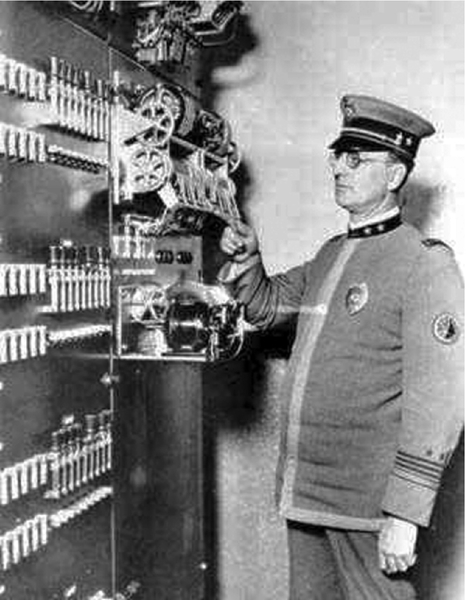
The first generation of access control systems is still in use today in the form of single-door hotel card systems (Fig. 3.2).1 In the first generation of security technology, CCTV and intercom systems were a rarity. CCTV systems were primarily limited to one camera displayed on a single monitor. For those few systems that had more than one camera, typically a monitor was used for each camera. Where intercoms were used at all, they were typically either custom installations or an extension of a business intercom.

The Second Generation
The second generation of access control systems networked eight card readers together to a dedicated computer that was approximately the size of a huge early electronic desk calculator (Fig. 3.3).2 There were typically a pair of keypads, a nixie tube display, and a 3-inch paper tape. When a person presented a card to the front door of a facility, one would hear the paper tape chatter and the nixie tubes would display something like 1CO3-AG. One would then refer to a book that would indicate that card CO3 was granted access to door 1.
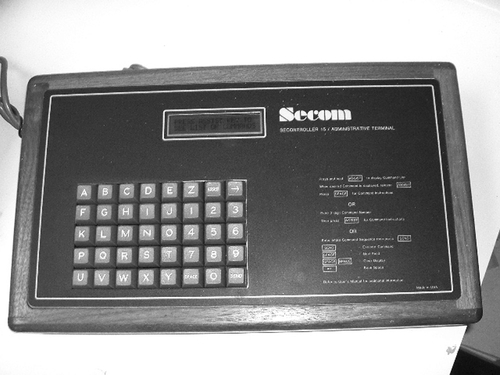
The second generation of alarm systems replaced the difficult-to-read meters and paper tapes with colored lamps and an audible alarm (Fig. 3.4).3 Each alarm had three colored lamps—green for secure, red for alarm, and yellow when bypassed. There was a switch to bypass the alarms. The second generation began in approximately 1945 and continues today. CCTV systems were still little used, but intercom systems were becoming slightly less than obscure.
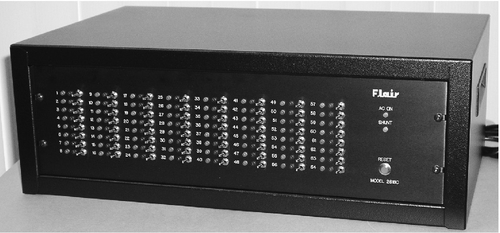
The Third Generation
The third generation began in 1968 and continued until approximately 1978. Third-generation systems combined alarm and access control into one system. Up to 64 card readers and up to 256 alarm points were wired individually back to a PDP-8 or IBM Series 1 minicomputer with core memory, a beehive® terminal, and a line printer. A basic 16 card reader system could cost more than $100,000. During this time, CCTV began to be used by corporations, and there were a few instances of intercom systems (Fig. 3.5).
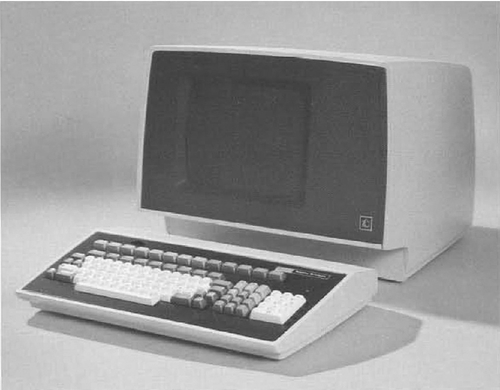
The Fourth Generation
In 1971, Intel introduced the first 4-bit microprocessor, the 4044, designed by Intel designer Ted Hoff for a Japanese calculator company. The processor boasted more than 2,300 transistors— more switches than ENIAC had, which filled an entire room and required a dedicated air-conditioning system just for the computer (Fig. 3.6). The 6502 and 8088 8-bit microprocessors soon followed. These became the basis for a new breed of alarm and access control system technology called distributed controller systems.
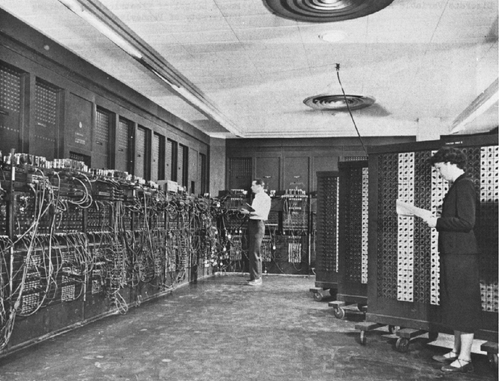
Until 1974, each alarm and access control field device was wired individually back to the minicomputer, where a jumble of wires fed into custom-made circuit boards. All that wire was costly and often cost prohibitive for most organizations. In 1974, one of the first distributed controller microcomputer-based alarm and access control systems was christened (by Cardkey®). It brought for the first time the ability to multiplex alarms and card readers into controller panels and network panels together into a distributed system. This was a radical change.
Finally, the cost of wiring, which was a major cost of early systems, was dramatically reduced. The earliest fourth-generation systems still terminated all these controllers into a central minicomputer, computer terminal, and line printer (early Cardkey 2000 system). The computers often had what I like to call a “user-surly” interface. When a person presented a card at the front door, the terminal still dutifully displayed something like “1CO3-AG” as the line printer chattered the same message. The console officer then looked that code up in a book.
Corporations began using intercoms and CCTV more extensively, although prices were still prohibitive for most users, with basic cameras costing as much as $1,200 each.4 Major advances in CCTV occurred during this period as well. For the first time, it was possible to use just a few video monitors to view many cameras because the cameras were finally being terminated into sequential switchers that switched the monitor view from camera to camera in a sequence.5
As the industry progressed, costs decreased dramatically and the systems became much more user-friendly.
CCTV systems saw major advances. First, the advent of consumer videocassette recorders helped reduce the price of video storage to practical levels. In the early 1990s, video was being multiplexed by splitting the 30 frames per second that the recorder used between various cameras so that each camera was recorded two or more times per second onto a single tape. This economized video storage even further. In the alarm and access control system industry during this time, minicomputers gave way to PCs and server-based networked systems.
The laggard was intercom technology, for which there was no single industry standard and little compatibility between manufacturers. It was also difficult to network together buildings or sites. Intercom usage was minimal in most systems, usually reserved to assist access at remote gates and doors.
By the mid-1990s, however, the manufacturers realized that organizations wanted to integrate their various systems, and they had begun to integrate alarm, access control, and CCTV and intercoms into truly integrated systems. These systems could detect an intrusion, automatically call up an appropriate video camera to view the alarm scene, and if an intercom was nearby, they could sometimes queue the intercom for response. They would also display not only the video but also a map showing the area of the alarm to help the console operator better understand what he or she was seeing on the video monitor. This was the earliest attempt at what would later become known as situational awareness software.
These systems were able to detect and respond in real time to emerging security events. However, the system interfaces were highly proprietary and clumsy. Achievement of an interface between any two brands and models of systems would usually not apply to any other brands or models. Each time integration was desired, it was always new turf.
Stalled Progress
Many leading consultants believed that true systems integration would be performed by alarm and access control systems.6 However, they were wrong. Significant progress stalled for more than a decade from the mid-1980s until after 2000. The fundamental reason for this dates back to the foundation of the industry. In the early days of fourth-generation microprocessor-based systems, 64 kilobytes of random access memory (RAM) cost more than $1,000.7 Because memory was so expensive, the founders of the industry solved the problem by putting the “personality” of the systems into erasable programmable read-only memory (EPROM). This meant that the systems functions were totally defined by the contents of their EPROMs. For the most part, their functions were not very field programmable. By the end of the 1990s, some of the leading systems had a seemingly infinite parts list, with a part for every function. This was because the industry had failed to change with the times. By 2000, it was possible to buy 64 megabytes of memory for approximately $10. That means that one could buy 1000 times the amount of memory for nearly 1/100 of the price of the 64 kilobytes of RAM in 1980. That is like getting a 747 airplane for the price of a pizza! As the computer industry surged forward with regard to capabilities and prices decreased dramatically, some consultants and integrators considered that the access control system industry was desperately trying to maintain its margins and was not generally implementing advances in system architecture. Accordingly, at the same time that microcomputer costs were decreasing, there were no significant reductions in access control system costs. The access control system industry was also hanging onto a long-term strategy of keeping its architecture as proprietary as possible while clients were increasingly asking consultants to design nonproprietary open-architecture systems. This strategy was doomed to fail.
Fourth-generation alarm and access control system architecture functions were defined by their physical attributes. They did what they did because of the programming attributes of the EPROM. Their functions were controlled by their physical environment.
A key strategic principle is that good security is achieved by controlling the environment. Any device that cannot control an environment different than the ones imagined by the product development designer is inherently limited in its ability to serve the needs of the client in controlling appropriate behavior. If you cannot control the environment, the environment controls you.
The fourth generation of alarm and access control systems was doomed by its failure to adapt to emerging trends of network technology, while trying to hold tenaciously to controller-based systems. Enter the fifth generation.
Fifth-Generation Technology
The problem with alarm and access control systems was that their manufacturers thought they were making alarm and access control systems (you read that correctly). What they were actually making were programmable logic controllers (PLCs), which were equipped with an alarm and access control system database. This is an important distinction because, in their failure to understand this, they clung to EPROM architecture. Although EPROMs solved the industry’s early problems of high memory costs, as memory costs plummeted, the industry confined its systems to the functions that its designers imagined for each box and implemented into the EPROM in the controller box. However, corporate and government clients all had special needs that could only be met with changes in the logic structure of the controller. For example, if a client needed a local alarm to sound at a door if it was held open too long during the daytime but wanted that door to alarm at the console immediately after hours, the client was sold an adapter box to perform this function for each door. Most manufacturers responded to such needs by building a long list of adapter boards and boxes to make their systems address each unique need. For those manufacturers who did not make a large assortment of these products, there were third-party manufacturers who did.
This strategy served the manufacturing community well but did not serve the clients so well because of the additional hardware and custom equipment required to perform perfectly logical functions needed by the average client. For example, if a client wanted to have confirmation of perimeter alarms by two detection systems (requiring both to trigger in order to cause an alarm but using each individually to cause an alert), most fourth-generation systems required each detection system to have its own inputs (providing the alert—the “or” function). Then the system would reflect the status of those inputs on output relays, which would then be hardwired together to create “and” functions, and those hard-wired outputs would be wired to additional inputs as “and” function alarms. This may not sound like a challenge, but for perimeter systems comprising 50 or more detection zones in each detection system, the cost of hardwire and wiring was often thousands of dollars more than the cost of a PLC-based system.
However, a few industry experts understood that there is no function desired by any client that cannot be performed by a simpler, not a more complicated, system architecture. Every imaginable function can be performed by a simple combination of inputs, outputs, memory, logic cells, counters, and timers. Like dancing, in which endless variety can be achieved with only a few basic steps, an endless variety of functions can be achieved with only these few basic logic objects. That structure defines PLC architecture. A few manufacturers introduced PLC-based alarm and access control systems, notably those who made building automation systems (BAS) that were already based on PLC architecture. However, these products never made a significant impact in the marketplace because the manufacturers continued to focus their marketing efforts on their BAS product lines instead of their access control system products.
The key to fifth-generation alarm and access control systems is that they are all based on entirely software-based functions, whereas earlier systems were based on functions that were defined in hardware. In the late 1980s and 1990s, however, the industry was driven to integrate multiple buildings and sites. The industry struggled with a variety of unsuccessful system architectures until it gradually adopted a network infrastructure already in place in most businesses—the local area network (LAN), municipal area network (MAN), and wide area network (WAN) Ethernet architecture. As the manufacturers began adapting their systems to Ethernet architectures, a convergence of security systems began to occur, bringing together alarm, access control, CCTV, and voice communication systems into a single integrated system.
That convergence continues today. In its next phase, distributed alarm and access control system controllers will possibly totally disappear as CCTV manufacturers realize that they can totally integrate alarm and access and intercom functions into their CCTV Ethernet architecture. This will result in a system that is composed entirely of “edge devices” (e.g., cameras, intercoms, door access hardware) and a server/workstation for the user interface. These are interfaced together on the LAN. Today’s digital video cameras already have digital signal processing (DSP) chips and up to 64 megabytes of RAM. Soon, each individual door’s access devices will be served by a single tiny controller in a junction box above the door. That tiny circuit board will comprise inputs, outputs, a card reader port, door lock output, and an exit device port, all served by a DSP chip and several megabytes of memory. A database of all users for that door will be contained in the DSP’s memory board. A single centrally located controller may manage all of the microcontrollers in the entire building.
As these edge devices begin to connect directly to the LAN without an intervening controller, costs will decrease dramatically. Although the industry seems to be concerned about this development, in fact it will result in a substantially higher use of the systems. The industry need not fear. In the same way that CCTV manufacturers feared the price drop below $1,000 per camera, only to find that camera sales soared, so too will alarm and access control and intercom sales soar as the introduction of microcontrollers causes prices to decrease. When these devices are combined with PLC programmability, which will allow an infinite variety of applications without an endless stock of hardware, the industry will finally have arrived. Within the next few years, the industry will very likely be served by only edge devices and software, connected together on a security LAN.
Avoiding Obsolescence
Obsolescence is a funny thing. When we specify obsolete equipment, it does not seem so at the time. How can we tell what is going to be obsolete? How long is a good enough life cycle? How about a migration path to the future? There are signs.
Planned Obsolescence
At one time, a major access control manufacturer had in its current line five different access control systems in which each was designed to serve a different market growth segment, from a small system that could support only approximately 32 readers to a large system that could serve multiple sites and could handle thousands of alarms, card readers, and other devices. None of those systems could migrate to the next. If a consultant were to specify a smaller system from this manufacturer, and the client outgrew that system in only 2 years, for example, the client would have to abandon much of the capital investment and purchase a new system. That is built-in obsolescence. That company does not exist anymore—it was bought by a big corporate integrator. Obsolescence is its problem now (and its clients’ problem too).
Unplanned Obsolescence
The industry is undergoing a sea change as this book is written. Much of today’s access control and video technology will not exist in any form within the next few years. How do I know? Market forces, that’s how. Some have argued that the industry has long been based on serving the manufacturers, not the clients. If that is true, information technology-based systems will largely end that. It is possible that someday the industry will manufacture edge devices and software, nothing else—no digital video recorders, no access control panels, nothing but small microcontrollers and digital cameras that connect field devices directly to and that are powered by the Ethernet and software. It is a good bet that all those bent metal boxes that manufacturers sell will be obsolete soon. This is about to become a very thin market with very few manufacturers (but with many software vendors in the early years). As this book was being written, the very first of these systems was introduced.
Summary
There are five generations of security system technology:
• The first generation included stand-alone card readers and McCulloh loop alarms.
• The second generation included centralized card readers on rudimentary processors and lamp-type alarm panels. Early CCTV cameras began to see some limited use.
• The third generation of systems included integrated alarm/access control systems on early minicomputers, slightly more CCTV usage, and the first use of business intercom systems for security.
• The fourth generation of systems introduced distributed processing panels for alarm/access control systems, major advancements in CCTV, and dedicated-use security intercoms. Systems integration began in the fourth generation.
• The fifth generation will likely be based on DSP-type microprocessors for alarm/access control system, with integral TCP/IP switchers that may integrate digital cameras and intercoms, all local to the door.
Questions and Answers
1. The earliest electric alarm system was a:
a. McDonalds Loop telegraph-type alarm system
b. McCulloh Loop telegraph-type alarm system
c. Patty O’Furniture-type alarm system
d. Scottish Accent Police Box
2. The first magnetic stripe access control cards appeared in the:
b. 1950s
c. 1060s
d. 1970s
3. In 1961, the London Police began using ________ to monitor train stations:
a. Closed Circuit Television (CCTV)
b. Scottish Accent Police Boxes
c. Blue Police Boxes that could travel through time
d. Modern Police Call Boxes
4. There have been _____ generations of Access Control Systems to date.
b. Three
c. Four
d. Five
5. The laggard in system progress was _________ technology, for which there was no single industry stand and little compatibility between manufacturers, and it was difficult to network together buildings or sites.
b. CCTV
c. Access control
d. Radio-controlled airplanes
6. Fourth-generation alarm and access control system architecture functions were defined by their ________ _________.
b. Data sheets
c. Physical attributes
d. Product installers
7. The problem with alarm and access control systems was that their manufacturers thought they were making alarm and access control systems. What they were actually making was __________________ with (continued into question 8).
a. Programmable Logic Controllers (PLCs)
b. Programmable Model Boards
c. Input and Output Boards
d. Alarm and Access Control Databases
8. The problem with alarm and access control systems was that their manufacturers thought they were making alarm and access control systems. What they were actually making was (answer to question 7) with _________________.
b. An alarm and access control database
c. An intercom system
d. Dog handling rule set
9. The key to fifth-generation alarm and access control systems is that they are based on entirely _________ _________ _________, whereas earlier systems were based on functions that there defined in (continued in question 10.)
b. Hardware-based functions
c. Software-based functions
d. Vaporware-based functions
10. The key to fifth-generation alarm and access control systems is that they are based on entirely (answer to question 9), whereas earlier systems were based on functions that there defined in (continued in question 10.)
b. Hardware
c. Vaporware
d. Vapid dreams
Answers: 1: b, 2: c, 3: c, 4: d, 5: a, 6: c, 7: a, 8: b, 9: c, 10: b
